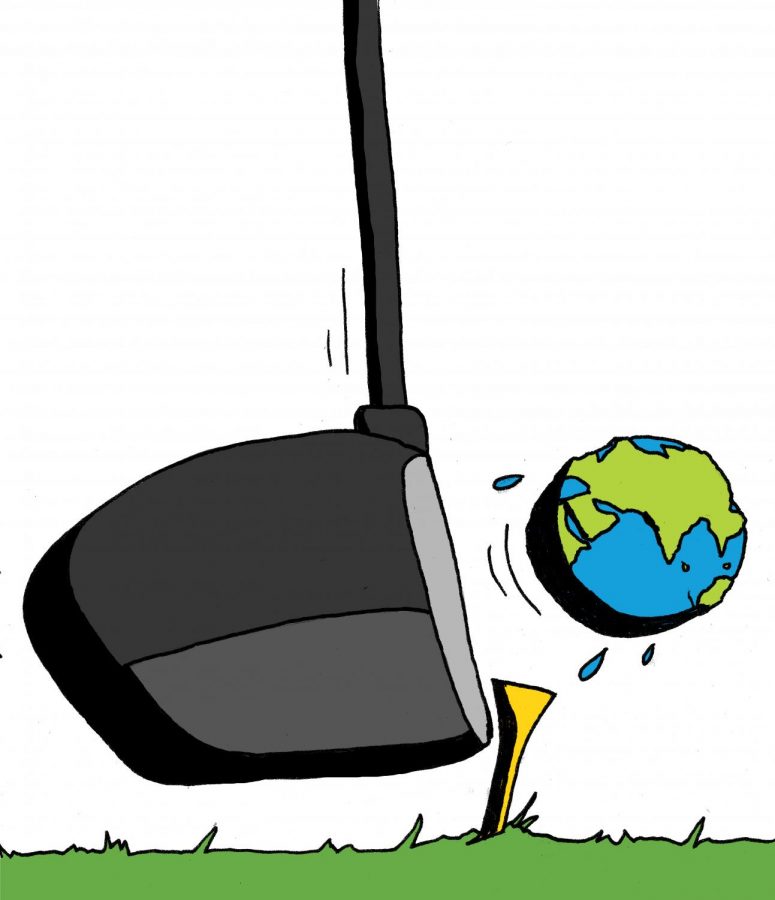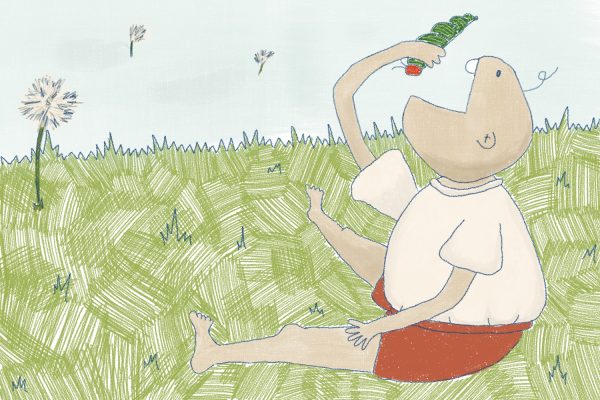Leave golf to the rich white man, save the planet instead
December 4, 2020
The Tee High golf course in Medford, Wisconsin is small as golf courses go. Sandwiched in between the Black River and a Chrysler dealership, its 9 holes are occupied largely by men in their sixties, middle school boys and their coaches, and my family and me who stand out like sore thumbs against a crowd of white khaki and blue polo shirts.
My family does not know how to golf, nor do we particularly enjoy it, with the exception of my father. But we play the course every time we visit my grandparents because we cannot go a day without some variety of physical activity, and well there’s little else to do in Medford, Wisconsin.
Regardless of how often we play, I remain a firm disbeliever in golf as an activity (I refuse to call it a sport as that would be misleading and dishonest). I find it dull, drawn out, and unreasonably difficult for a game that only requires you to hit things with a stick and walk from place to place.
My friends who are passionate about golf tell me the only reason I don’t like it is because I’m not good at it, which is fair reasoning- anything I don’t excel at is coincidentally not worth my time. But there are definitely other reasons.
Golf is single handedly the most elitist and exclusive game in the industry. It also happens to be terrible for the environment, and dominated by the millionaires and billionaires of the world. The game itself does little to make up for its shortcomings.
It’s no secret that golf is dominated by rich, white men – likely because they’re the only demographic with personalities equipped to enjoy such an activity. Up until recently, I didn’t realize how much they control the industry.
The Royal and Ancient Golf Club in St. Andrews, one of the most prestigious courses in the world and the self proclaimed “spiritual home of golf,” only admitted its first female member in 2014, after 260 years of strict male only membership.
Of the 250 professional players on the PGA Tour, four of them are black. Only six percent of all NCAA golf athletes are black, Latino or Native American, according to a 2019 New York Times article.
Some clubs in the United States have admitted their first black members in just the past few years.
All of these happenings are regaled as “achievements,” these individuals honored as “trailblazers.” I find it to be quite pathetic.
And while Tiger Woods, a person of color, remains the best professional golfer in the world that does not suddenly make golf the poster child for diversity. And while there are certainly many famous people of color who enjoy playing golf as an activity (i.e. Barack Obama, Michael Jordan, etc), that does not excuse the classism golf exhibits.
Because even with their sudden acceptance of women and minorities, golf is far from being accessible or inclusive.
Sam Jefferson, a freshman at UVM, and a fellow cynic opinion columnist says, “I find golf etiquette to be very white and elitist. You have to dress in uniform at a lot of clubs, with tucked in buttoned shirts, a belt, golf shoes… most beginning club sets cost hundreds of dollars and then you have to buy golf balls too.”
Additionally, golf is incredibly harmful for the environment.
The average 18 hole golf course covers the equivalent of 70 football fields.
Mowing that much space releases copious amounts of carbon into the atmosphere, crippling our already handicapped ozone. Fertilizer can be detrimental to local ecosystems due to runoff and water pollution. Many golf courses use rivers as their water traps, so if the thousands of lost golf balls aren’t poisoning the fish, I’m sure the fertilizer will do the trick.
But the real concern has to do with water.
Courses in cooler, wetter climates can get by with using one acre-foot of water per acre, per year- or 325, 851 gallons. Courses in hotter, more arid climates require six acre-feet of water, per acre, per year.
So if there are roughly 15,500 golf courses in the US alone, each sporting an average of 150 acres of land. That’s at least 2,250,000 acres of land that need to be constantly watered.
Water has always been a finite source, and in the past few decades, we’ve started to see just how precious it is. Flint, Michigan is entering its seventh year without clean water. The Western United States has suffered its worst extended drought since 2013, according to a 2020 Washington Post article.
In 2021, scientists expect 40 out of 50 states to expect water shortages, according to a 2020 article from National Geographic.
Meanwhile, billionaires and celebrities tee off on turf grass that swallow enough water to supply over a thousand households a year.
It’s time we reset our priorities. Some scientists give us until 2071 before we completely diminish our water supply. I think in that time, we can scratch the Golf Channel off our streaming services, and pack up the golf carts and caddies.
My friend Anna has a masterplan to plant bamboo on every golf course in the country, as the plant is highly invasive and once it’s been planted, it can’t be uprooted. We’ll meet you at the front gates of the Spear St course. Bring a shovel.
















![Can’t buy me [self] love](https://vtcynic.com/wp-content/uploads/2024/04/self-care-FINAL-600x398.jpg)

Chaunce Benedict • Dec 7, 2020 at 6:44 pm
Well done. One note further: pesticides, herbicides, etc. are massively applied to golf courses. They are an environmental health nightmare.